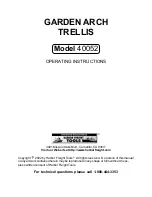
INSTRUCTIONS FOR USE AND CARE
1. An adequate respiratory protection program must
include knowledge of hazards, hazard assessment,
selection of proper respiratory protective equip-
ment, instruction and training in the use of equip-
ment, inspection and maintenance of equipment,
and medical surveillance.
2. This respirator will perform as designed only if
used and maintained according to the manufactur-
er's instructions. The Program Administrator and
the users must read and understand these instruc-
tions before using or servicing this product.
3. If the respirator does not perform as specified in
this manual, it must not be used until it has been
checked by authorized personnel.
4. Do not alter, modify, or substitute any components.
5. Inspect the respirator regularly and maintain it
according to the instructions. Repairs must only be
made by properly trained personnel.
6. This respiratory protective device does not supply
oxygen. Use only in adequately ventilated areas
which conform to the appropriate standard.
7. This respirator must be used in conjunction with
the proper chemical or particulate canis-
ter/cartridge(s) for protection against specific con-
taminants. If you cannot determine that the filter
canister/ cartridge(s) used with this device is
designed for the contaminant, or if you do not
know the identity of the contaminant, do not use
this device.
8. Do not use when concentrations of contaminants
are unknown.
9. Do not use when appropriate exposure limit (PEL,
REL, TLV, etc.) is not known.
10. Leave the contaminated area immediately if:
a. Breathing becomes difficult
b. Dizziness or other distress occurs
c. You taste or smell the contaminant
d. You experience nose or throat irritation
e. Instructed by responsible individuals
11. Use strictly according to the instructions, labels,
and limitations pertaining to this device. Follow an
established canister/cartridge(s) change-out
schedule.
12. This respirator may not provide a satisfactory seal
with certain facial characteristics, such as beards
or large sideburns, that prevents direct contact
between the skin and the sealing surface of the
facepiece. Do not use this facepiece if such condi-
tions exist.
13. Do not wear eyeglasses under the facepiece. The
temples or sidebars on eyeglasses will prevent an
air-tight seal. If you must wear glasses, install the
spectacle kit.
14. The user must perform a respirator fit test
(Quantitative Test or Qualitative Test) and follow all
warnings and limitations specified.
15. Wear impermeable protective clothing to prevent
exposure to gases and vapors which can poison by
skin absorption.
16. Do not use this full facepiece with self-contained
breathing apparatus (SCBA) unless equipped with
a push-to-connect inlet.
17. Do not use this respiratory protective device in
explosive atmospheres.
18. Do not use for urethane paints or other paints con-
taining isocyanates unless an appropriate cartridge
change-out schedule is developed. Due to their
poor warning properties, overexposure can occur
without user awareness and result in severe per-
manent damage to the respiratory system. If
unable to develop an appropriate change-out
schedule, use an air-supplied respirator or SCBA.
Failure to follow all warnings, instructions, and estab-
lished protective measures can result in serious per-
sonal injury or death.
•
This respirator/filter provides LIMITED protection.
It may help reduce exposure to airborne biological
agents, including H1N1 (swine) flu virus, avian
(bird) flu virus, other types of influenza, SARS, or
other bacterial or viral biological agents and help
reduce the risk for influenza infection during a pan-
demic, but will NOT eliminate the risk of exposure,
infection, illness, or death.
•
This respirator/filter is certified by NIOSH to com-
ply with the requirements specified for the desig-
nated filter efficiency level; however, appropriate
authorities have NOT established a safe level of
exposure to biological agents. Therefore, the respi-
rator may NOT prevent transmission of influenza
virus.
•
Refer to the Centers for Disease Control and
Prevention (CDC) at www.cdc.gov for guidance on
the use of respirators to help decrease exposure to
H1N1 virus or other airborne biological agents in
community, home, and occupational settings. The
CDC recommends fit testing, medical evaluations,
and training for optimal effectiveness when a res-
pirator is used in a non-occupational setting.
Neglecting these preparatory measures may cause
an unsafe condition. Respirators used in an occu-
pational setting MUST be used in accordance with
a complete respiratory protection program as
required by OSHA, which includes proper selec-
tion, training, fit-testing, and fit-checking. Detailed
information on a respiratory protection program is
available by contacting OSHA or visiting
www.osha.gov.
•
Do NOT remove respirator in contaminated areas.
The outer surface of the respirator MUST be treat-
ed as if it is contaminated at all times. Tight-fitting
3
TAL 018 (L) Rev. 6 - 10073772
Содержание Advantage 4000 Series
Страница 8: ...NOTES 8 TAL 018 L Rev 6 10073772 ...
Страница 10: ...NOTES 10 TAL 018 L Rev 6 10073772 ...
Страница 12: ...NOTES 12 TAL 018 L Rev 6 10073772 ...
Страница 20: ...NOTES 20 TAL 018 L Rev 6 10073772 ...
Страница 22: ...NOTES 22 TAL 018 L Rev 6 10073772 ...
Страница 24: ...NOTES 24 TAL 018 L Rev 6 10073772 ...
Страница 26: ...NOTES 26 TAL 018 L Rev 6 10073772 ...
Страница 31: ...31 TAL 018 L Rev 6 10073772 ...
Страница 32: ...32 TAL 018 L Rev 6 10073772 ...
Страница 33: ...33 TAL 018 L Rev 6 10073772 ...
Страница 34: ...34 TAL 018 L Rev 6 10073772 ...
Страница 35: ......
Страница 36: ......




































